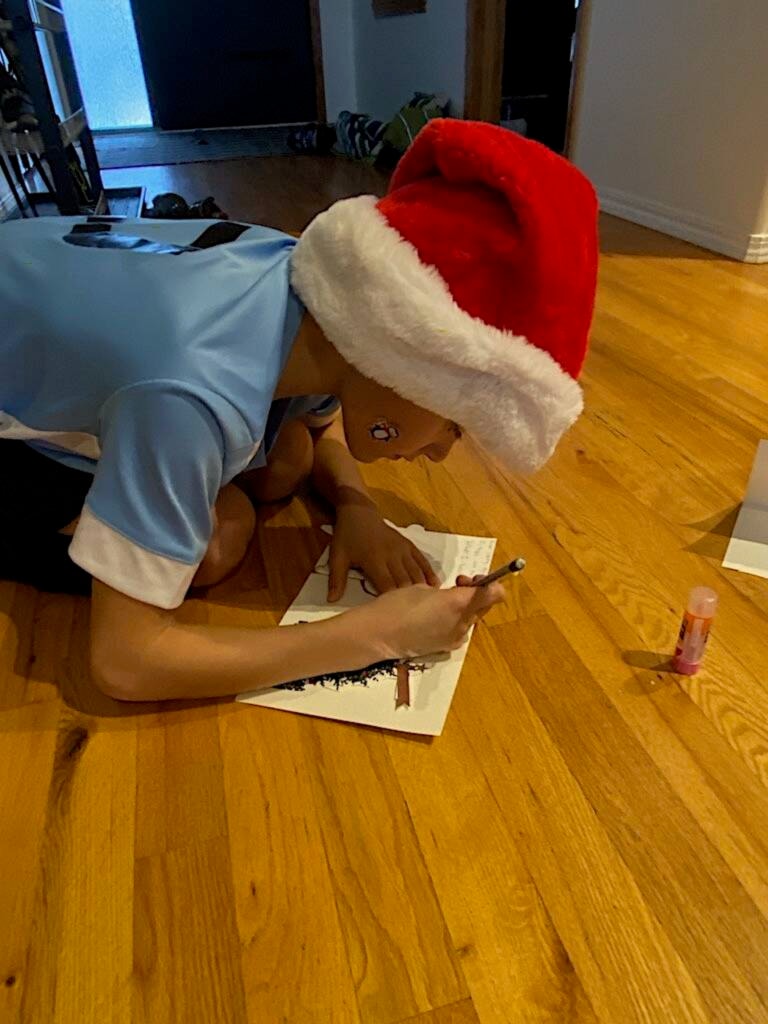The Red Deer family involved in Canada’s Live Net Zero challenge may be facing their biggest test yet — Christmas — the holiday season synonymous with over-consumption.
Since fall, the Richmond family, one of five families across the country facing off in the contest launched by Canadian Geographic, has been identifying their biggest sources of carbon emissions, retrofitting and making behavioural changes.
For Christmas, Ania Richmond and her family have reflected on celebration fundamentals — Christmas trees, gifts, Christmas cards, food, and travel.
She said a live Christmas tree versus an artificial is not as simple as going with the natural option.
“One of the things that I think we learned through this challenge quite intensely is that a really important part of the equation is the waste that we generate,” said Ania whose family has always gone artificial.
“I’d like to get a real one now. But the reality is our Christmas trees are perfectly fine. They’re not old. They’re not damaged. They’re not needing to be replaced. So to generate garbage for the sake of just generating garbage isn’t the smart thing.”
Ania said artificial trees are only used for a few weeks each year so they can last a long time, so the plan is to keep using them forever, just like her parents.
But a fake tree she had bought to put outside on the doorstep will be returned to the store, and a real tree may be purchased instead.
Related:
She said taking into consideration carbon emissions at Christmas doesn’t have to be all or nothing. It’s just about having some awareness and making decisions, possibly changes, that will become habit.
“Just consider the energy efficiency factor in your plans. It doesn’t have to derail what you do. It doesn’t have to blow things up. Just bring it in like other factors when you make a plan.”
For Ania, traditional Polish recipes have always been part of Christmas. But this year instead of using imported ingredients, like herring and dried mushrooms, she will incorporate more local substitutions into holiday meals.
“There is a really big carbon footprint in the food you eat. I’m not necessarily giving up my traditions. I’m making adjustments to the environment I’m living in so I can be more sustainable.”
In recent years the Richmonds switched to reusable cloth bags to wrap gifts instead of wrapping paper that can’t be recycled.
“Usually there’s two or three big, black garbage bags of wrapping paper after this Christmas morning moment of opening gifts. Our pile of garbage after Christmas was the name tags. It was a handful of paper because we use cloth bags that we just use over and over and over again every single Christmas.”
Using recyclable wrapping paper, or other paper that can be recycled, are also good options, she said.
Related:
She said a movement is already underway for families to look for used items to give as gifts, especially for young children, who quickly outgrow clothes or toys. The gift of time, like babysitting, would also be a welcome gift to parents, instead of giving people things that they won’t use.
Ania also plans to introduce people to sustainable products by giving them as gifts so they so can give them a try.
“I’ll aim to do that as much as I can without being preachy about it,” she laughed.
At some point during the Christmas season, the Richmonds intend to head to the mountains in their hybrid vehicle which produces four times fewer carbon emissions than their SUV.
Whether or not to mail Christmas cards was a more difficult decision, despite the carbon emissions from producing cards, transportation to send them around the world, and the garbage they create.
Ania said she became really sad when she thought about giving up cards, so she came up with a compromise.
“I still think there’s some value in some traditions that enable our relationships to be nurtured. There is worth in that. There is value in that. So where I’ve landed is I’m going to reduce how many cards I send.”
She also spent a fun afternoon with her sons and nephew cutting up old Christmas cards to create new cards with recycled paper and the plan was to include personal letters.
Ania said reducing your carbon footprint doesn’t have to be painful at Christmas. People don’t have to make a lot of changes, but every incremental change adds up for the environment.
“If we all do it in a small way, the sum of all those small contributions is really big, and it’s really powerful. Imagine what your whole neighbourhood can accomplish together.”
The Richmonds are posting about their journey at www.facebook.com/ania.kania.522 and www.instagram.com/livenetzero_alberta.
